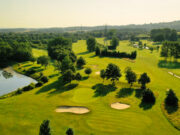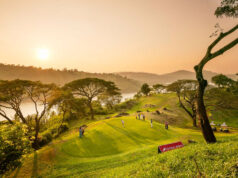Waiting for the luggage at Myrtle Beach airport you realise this is no ordinary destination when the first half-a-dozen bags to clunk onto the carousel are all sets of golf clubs. At most airports golf gear comes off last and it’s significant that it’s treated with a great deal more respect here in the USA’s golf capital.
In fact, the clue to golf’s status in this part of the world came earlier when boarding the connecting flight from Charlotte, North Carolina. Not only were the passengers overwhelmingly male but there was also a fair bit of banter going on. “Marty, remember that nine-inch putt you missed on the 18th at Flying Prawn?” There was a lot of that sort of thing going on.
And if the banter and bags aren’t enough to convince you that you’ve arrived in the most popular golf destination in America then take a look at what’s on the other side of the road directly opposite the terminal and right behind the taxi rank. Yes, you guessed it, a golf course.
SUPERSIZED SUPERSTORES
There are more than 100 of them and they are everywhere; on the corner of the street, behind the big hotel, next to the drugstore. You can’t swing a seven-iron without clipping at least one. And there are all manner of related activities. There’s a shop the size of an aircraft hangar selling nothing but golf shoes. And the PGA Tour Superstore covers roughly the same area as the front nine of the Old Course at St Andrews. It’s massive. No fewer than three aisles are totally devoted to the widest range of tee pegs you could possibly imagine. For example, there are ‘Senior’ tees where the cup is much larger presumably to make it easier for a trembling hand to rest a ball on. Yanks not only think of everything but have the determination, energy and money to follow through on their daft ideas.
From daft to what we call crazy and the extraordinary number of miniature putting layouts are scattered about. These aren’t the gentle sort you might find in Bognor or Skegness where a windmill presents the greatest obstacle. No, they are far more sophisticated. Mayday Miniature Golf, for example, begins with a mock airplane ride that ends in disaster and leaves players stranded on a tropical island. Then there’s Jungle Lagoon, Treasure Island, Molten Mountain (complete with exploding volcanoes), Dragon’s Lair, Hawaiian Rumble and Captain Hook’s Adventure.
And then there are buggies. Freed from the confines of the golf course, they zip around downtown like demented beetles. Apparently, they can be driven everywhere except on freeways.
THE GREAT WHITE SHARK SERVES STEAKS
A booming holiday resort, Myrtle Beach has all the associated attractions and facilities including a rich range of restaurants and bars. Even here you can opt for a golf connection and dine in Greg Norman’s steakhouse or drink in Banditos, a bar in which local boy Dustin Johnson has a share. If you like seafood, you’re spoilt for choice and, if you can’t get enough shrimp and swordfish, the all-you-can-eat buffets are the way to go.

As you might not unreasonably expect, there is a beach in Myrtle Beach. In fact, it’s a lovely sandy one that stretches the whole length of the coast and probably explains why the area is nicknamed the Grand Strand.
There’s also the famous Intracoastal Waterway, a sort of aquatic motorway that passes through Myrtle Beach on its way from New Jersey to the Gulf of Mexico. Expensive looking boats cruise south along it in the winter and return back north in the summer.
BRUTAL ICE STORM
Following the same migratory pattern but preferring to fly rather than sail are humans known as ‘snowbirds’. They are mostly elderly folk who escape south from Canada and the north-east of the USA annually after Thanksgiving (November) and return north around Easter. Typically, they will own a condominium (‘condo’) on or near the beach into which they hibernate. However, they don’t always escape the bad weather entirely. The 2013/14 winter, for example, was particularly harsh and Myrtle Beach suffered a brutal ice-storm which damaged thousands of trees and caused a great deal of havoc. That, of course, was extremely unusual as ordinarily snow falls about once a decade and soon disappears. The day temperature in January and February is usually about 55 degrees Fahrenheit and year-round golf is rarely interrupted.

Golf began in Myrtle Beach back in 1927 with the opening of what was then the Ocean Forest Country Club. Now re-named Pine Lakes and known as the ‘Granddaddy’, it underwent an extensive multi-million dollar renovation in 2006 and is a delightfully open and enjoyable course that weaves gently around woods and lakes. It’s not hilly and walking is an appealing option, which is not always the case in the cart-obsessed USA.
SIPPING BOURBON AND PUFFING FAT CIGARS
Just as impressive at the course is the majestic clubhouse, which has also benefited from a major makeover. A classic example of graceful southern architecture, it’s huge. Wander around it and admire the imposing ballroom where you can easily imagine regular visitors such as Messrs Rockefella and Vanderbilt sipping bourbon and puffing on fat cigars.
It took another 21 years after the first before a second course arrived. 1948 was an auspicious year not only because the Dunes Golf and Beach Club opened but also because your correspondent was born. When I commented on this coincidence, my playing partner was unkind enough to observe that the years had taken less of a toll of the course than they had of me.

Designed by Robert Trent Jones Sr, it has been tweaked a few times, most recently last year when it was lengthened to 7450 yards, at least partly because it’s the regular venue of the PGA Professional National Championship. Regarded by many as the best course in the area, it’s a real treat and thoroughly deserves its high ranking.
ALLIGATOR ALLEY
The most famous stretch is ‘Alligator Alley’ from 11 to 13. The 13th is the signature hole, a glorious par five which skirts Lake Singleton. A plaque on the tee commemorates some hapless hacker’s 22 without, it stresses, ever entering the lake. While the lake is certainly a hazard, possibly of even greater concern is the presence of a number of alligators both in and out of the water. These beasts are not uncommon in Myrtle Beach and the sensible advice is to sacrifice your ball, irrespective of how new it is, rather than venture too close. Although assured they don’t eat when the temperature is below 70 Fahrenheit, it wasn’t a theory I was especially eager to test.
The only slight disappointment is that, apart from a couple of peeks on 10 and 18, you can’t see much of the sea. But you can from the clubhouse, which overlooks a beautiful beach and contains a lovely sepia photo of Max Faulkner and Harry Weetman playing the course after the Ryder Cup at Pinehurst. To give you some idea of how long ago that was, America won!
GOLF’S PERFECT STORM
While the golf expansion that transformed Myrtle Beach got gently underway in the late 1960s, it didn’t escalate into a full-blooded boom until the 1980s when courses began popping up all over the place. The benign climate, sandy terrain and existing tourism infrastructure, created the perfect storm. The standard formula was to create a course, build a number of attractive properties around it, add an imposing entrance with neat flowerbeds and then stand back and await a rapid influx of dollars.
From a three-months-a-year destination, Myrtle Beach morphed into a year-round proposition with golf right at the heart of it all. Also significantly broadened was its appeal to a wider range of socio-economic groups from those on a tight budget to the extremely well-heeled.
MONDAY AFTER THE MASTERS
While the former might opt to rent a condo, the latter may prefer to stay in one of the several first-class resorts. Barefoot boasts no fewer than four fabulous courses. You can probably guess the architects from the name each bears – Love, Norman, Dye and Fazio. I only played a full 18 around the Love and, well… er, loved it. The only perplexing thing about it was whether ruins, which feature on the front nine, were genuine on not. Research revealed them to be the “recreated ruins of an old plantation home”, which is perhaps no more than one club’s length away from authentic.
The (Pete) Dye course is the regular venue for a Pro-Celebrity-Am charity tournament called “Monday after the Masters” which, if you guessed who designed the course, you can probably have an intelligent stab at when it’s played. It’s a six-person Texas scramble that takes almost as long to play as the Masters itself. Featuring a fistful of top pros and a number of NFL stars, it raises an awful lot of money for a very worthwhile cause.
A RICH ASSORTMENT
OF WILDLIFE
As well as at Barefoot, Tom Fazio has designed another quality course in the area – TPC Myrtle Beach. It weaves its way through towering pines and is an absolute cracker. Set in tranquil surroundings, all you can hear is melodious birdsong, the occasional hammering of Woody Woodpecker and the unmistakable sound of flapping butterfly wings. Bald Eagles spiral silently overhead as you line-up a tricky putt on the super-slick greens. Picturesque lakes add to the enormous visual appeal while numerous broad swamps demand a decent carry off several of the tees. Manicured to perfection, TPC Myrtle Beach has hosted the Senior Tour Championship and rightly belongs right up there with the very best.
WHY WE LIKE IT
Sadly, there aren’t very many towns where you can walk down the high street with a bag of clubs slung over your shoulder and not feel extremely self-conscious. Refreshingly, it’s the non-golfers who are the minority in Myrtle Beach.
The seafood is so sensationally good that you should stuff down as many lobsters, prawns and crabs down your throat as you can reasonably manage without being violently ill. And those unfamiliar with grits should try a few at breakfast simply so they can tick them off their list.
Clive ‘Silky Swing’ Agran rather immodestly describes himself as ‘the most gifted golf writer either side of the Urals’. His sports writing career began in 1989 when he joined Eurosport. His immensely popular ‘Single Figures or Bust’ series in Golf Monthly both reduced his handicap and raised his profile.























